Overview
The article provides a comprehensive step-by-step guide on how to use the ReplaceValue function in Power Query, emphasizing its role in data cleaning and transformation processes. It outlines the function’s syntax, practical applications, troubleshooting tips, advanced techniques, and best practices, demonstrating how effective use of ReplaceValue can enhance data reliability and operational efficiency in business intelligence contexts.
Introduction
In the realm of data management, efficiency and accuracy are paramount, especially when it comes to transforming datasets for analysis. The ReplaceValue function in Power Query emerges as a powerful ally for users striving to enhance their data cleaning processes. By enabling seamless value replacements, this function not only corrects inaccuracies but also standardizes entries, paving the way for reliable insights.
As organizations increasingly adopt Robotic Process Automation (RPA) tools like EMMA RPA and Power Automate, the integration of such capabilities becomes essential for streamlining workflows and minimizing manual intervention.
This article delves into the intricacies of the ReplaceValue function, offering:
- Practical applications
- Troubleshooting tips
- Advanced techniques
to empower users in their data transformation journey. By mastering these tools, businesses can unlock the full potential of their data, driving informed decision-making and fostering growth in an ever-evolving digital landscape.
Understanding the ReplaceValue Function in Power Query
The Power Query ReplaceValue function is an invaluable tool for users aiming to streamline their cleaning processes by substituting specific values within a column. This capability is especially advantageous for correcting errors and standardizing entries, ensuring that your information is both accurate and reliable. By incorporating Robotic Process Automation (RPA) into your workflows, such as utilizing EMMA RPA or Automate, you can improve efficiency and lessen the manual effort involved in preparation tasks.
Notably, Power Query performs data profiling over the first 1,000 rows of your data by default, allowing users to assess the quality and distribution of their datasets effectively. The syntax for the power query replacevalue method is structured as follows: Table.ReplaceValue(table as table, oldValue as any, newValue as any, replacer as function). Here’s a detailed breakdown of the parameters involved:
- table: This represents the input table you wish to modify.
- oldValue: This is the value that you aim to replace.
- newValue: This is the value that will take the place of the old value.
- replacer: This parameter specifies the method that determines how the replacement will take place, with
Replacer.ReplaceValuebeing the common choice for straightforward value substitutions.
Understanding the nuances of this function is crucial, as it establishes the foundational capability for transforming information with power query replacevalue. By mastering power query replacevalue, users position themselves to efficiently clean and prepare their datasets for analysis, aligning with the increasing emphasis on effective transformation techniques in analytics throughout 2024.
A recent case study on information profiling illustrates that understanding the quality and distribution of information is essential for effective cleaning, especially in light of challenges like poor master information quality and barriers to AI adoption. Recent updates to Query have further refined these functionalities, enhancing users’ ability to manage and manipulate their information with greater precision. Unlocking the power of Business Intelligence through these transformation techniques can drive informed decision-making, ultimately supporting your organization’s growth and strategic objectives.
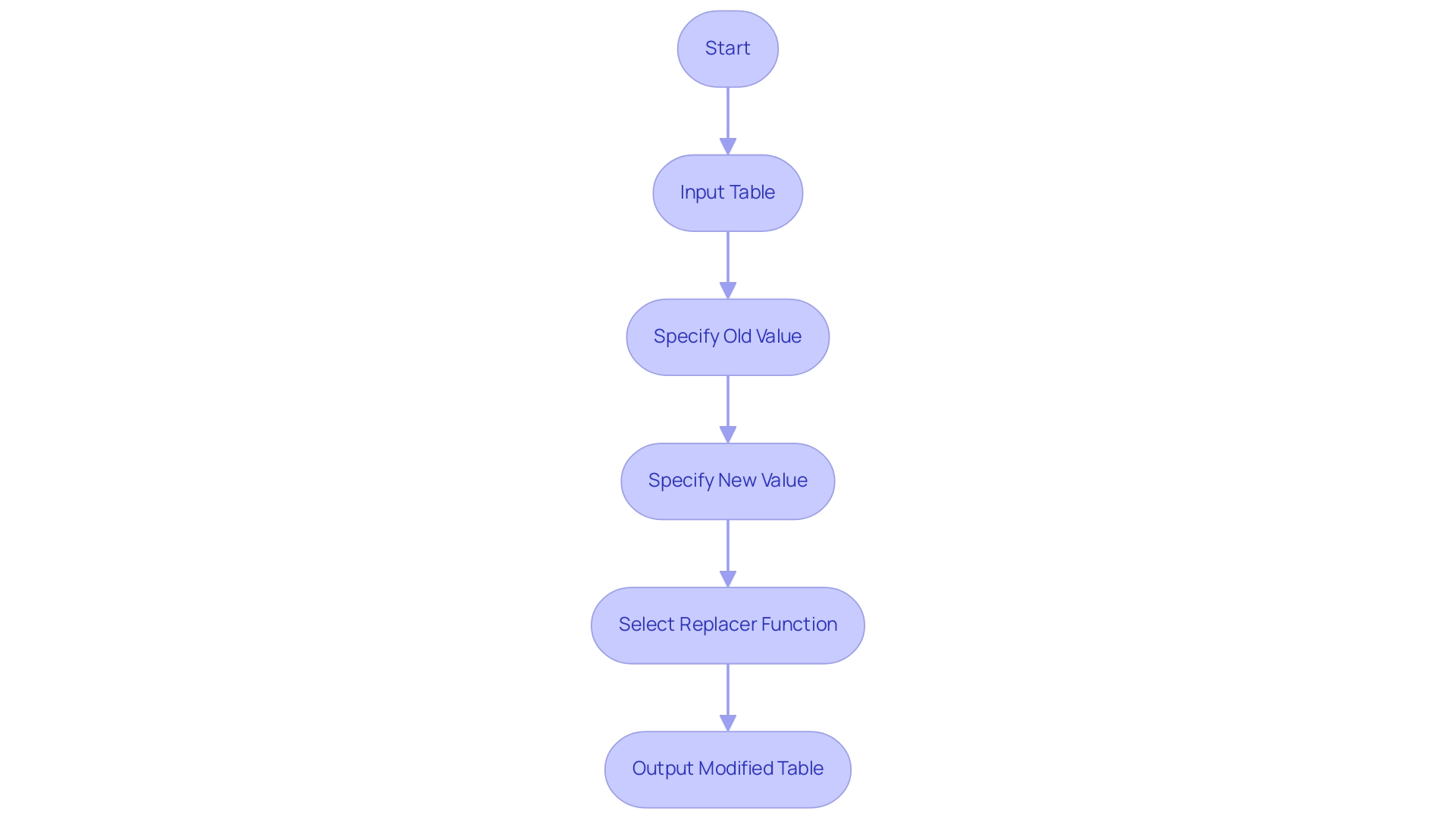
Practical Applications of ReplaceValue: Step-by-Step Examples
Let’s delve into practical applications of the Replace Value function in Power Query, which can significantly enhance your data cleaning processes and support your business intelligence initiatives, particularly when paired with RPA solutions like EMMA RPA and Power Automate for improved operational efficiency:
- Correcting Typos: Imagine a scenario where your product database contains misspellings. For instance, if ‘Appl’ is incorrectly listed instead of ‘Apple’, you can rectify this easily with the following command:
Table.ReplaceValue(yourTable, 'Appl', 'Apple', Replacer.ReplaceValue, {'ProductName'})
This simple replacement ensures your product names are accurate, improving overall data reliability and empowering your decision-making processes.
- Standardizing Values: Information inconsistency can hinder analysis, particularly when poor master quality is an issue. If your dataset shows varying formats for ‘Yes’ and ‘No’ responses, such as ‘Y’ and ‘N’, standardizing these can streamline your processing.
Use:
Table.ReplaceValue(yourTable, 'Y', 'Yes', Replacer.ReplaceValue, {'Response'})
Table.ReplaceValue(yourTable, 'N', 'No', Replacer.ReplaceValue, {'Response'})
This method ensures uniformity across your responses, enhancing clarity and operational efficiency. Additionally, as highlighted by the PROPER formula in Excel, proper formatting is crucial for maintaining information quality, ensuring consistency in textual content.
- Updating Status Codes: When replacing status codes, like translating ‘1’ to ‘Active’ and ‘0’ to ‘Inactive’, you can utilize:
Table.ReplaceValue(yourTable, 1, 'Active', Replacer.ReplaceValue, {'Status'})
Table.ReplaceValue(yourTable, 0, 'Inactive', Replacer.ReplaceValue, {'Status'})
This step not only clarifies status indicators but also aids in data interpretation, facilitating better decision-making in your operations.
These examples demonstrate the effectiveness of the power query replacevalue function for cleaning and transformation activities in Query. By automating these menial tasks, the power query replacevalue feature enables users, even those without coding expertise, to maintain quality and prepare sets efficiently for further analysis. As Harry Fry once stated, “If you can’t explain something to a five-year-old, you don’t really understand it yourself,” highlighting the significance of clarity in information processes.
Moreover, understanding the quality and distribution of information is essential for effective cleaning, especially as organizations face barriers to AI adoption due to information quality issues. The case study on information profiling demonstrates how users can gain insights into the structure and characteristics of their dataset, helping to identify potential issues and anomalies. Such insights improve the efficiency of the value substitution process and contribute to your business’s growth and innovation.
Remember, failing to extract meaningful insights from your information can leave your business at a competitive disadvantage, underscoring the urgency of adopting effective management practices.
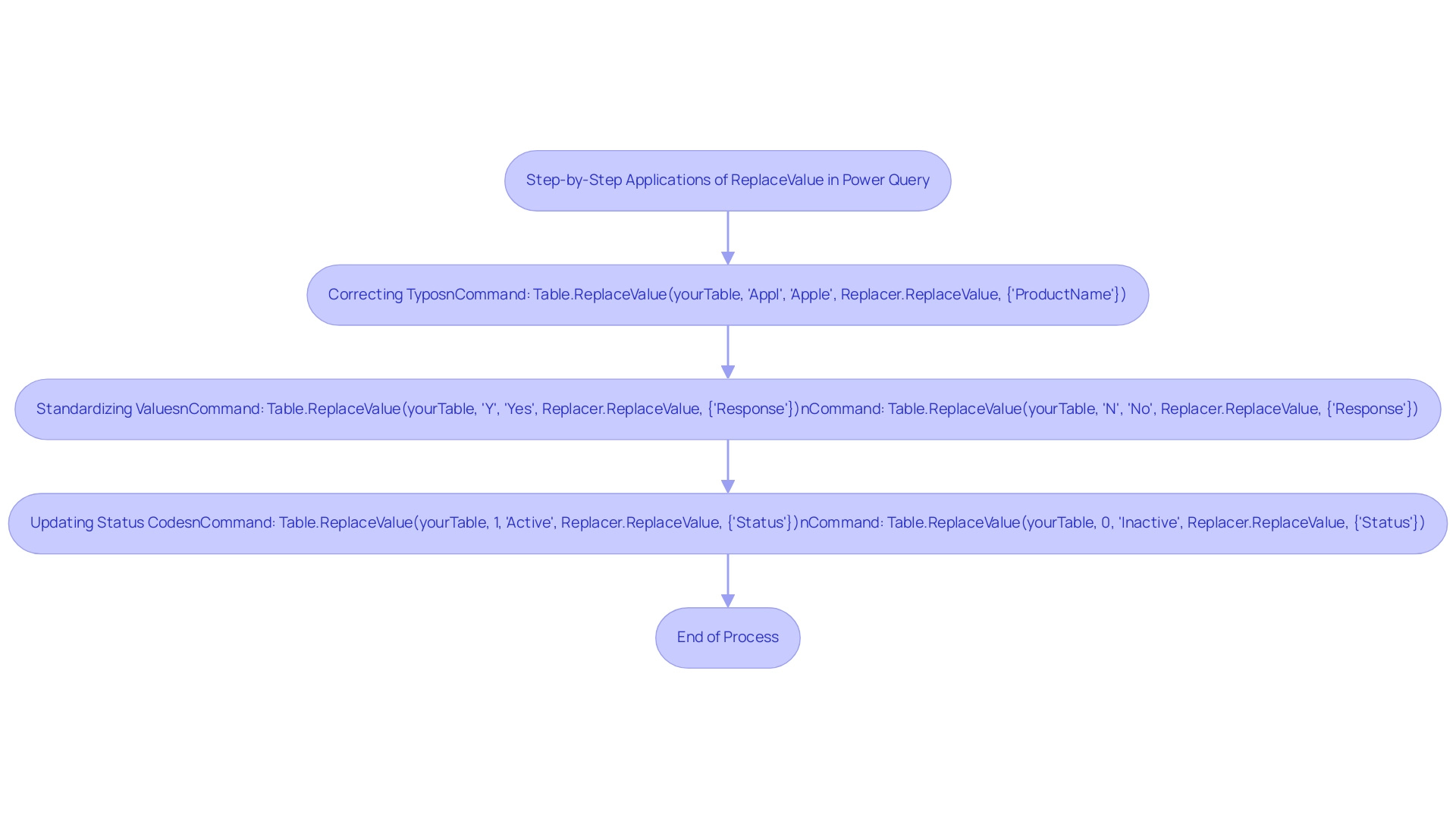
Troubleshooting Common Issues with ReplaceValue
When employing the substitution method in Power Query, users may face several typical problems that can obstruct their transformation efforts, particularly in the context of addressing technology implementation challenges. Considering that 44% of organizations are worried about needing to form a team to lead their transformation, tackling these challenges is essential for effective information handling. Here are key challenges and their corresponding solutions:
-
No Changes Made: If the power query replacevalue function seems ineffective, first verify that the
old Valuespecified is present in the dataset. It’s essential to check for any leading or trailing spaces that might prevent a match. -
Information Type Mismatch: A common problem occurs from type mismatches. Ensure that both the old and new values share the same data type; for instance, if replacing a text value, the new value must also be of text type.
-
In situations needing the substitution of several values, it is essential to call the value replacement method multiple times or use a list for efficient bulk substitutions.
-
Case Sensitivity: The value replacement operation is case-sensitive, meaning that substituting ‘apple’ will not impact ‘Apple’. To address this, handle each case specifically or consider employing a case-insensitive approach with power query replacevalue.
By recognizing these common pitfalls and applying the provided solutions, users can troubleshoot effectively, enhancing their use of the ReplaceValue function. This not only assists in smoother information manipulation but also aligns with the broader organizational goals of optimizing resources and driving transformation effectively. RPA can streamline the process by automating repetitive tasks associated with data manipulation, thus improving operational efficiency and reducing errors.
As organizations increasingly focus on selecting the right technology solutions for their digital transformation, effective troubleshooting of tools like Query is essential for achieving these objectives, ultimately leveraging RPA and tailored AI solutions to drive data-driven insights and operational efficiency.
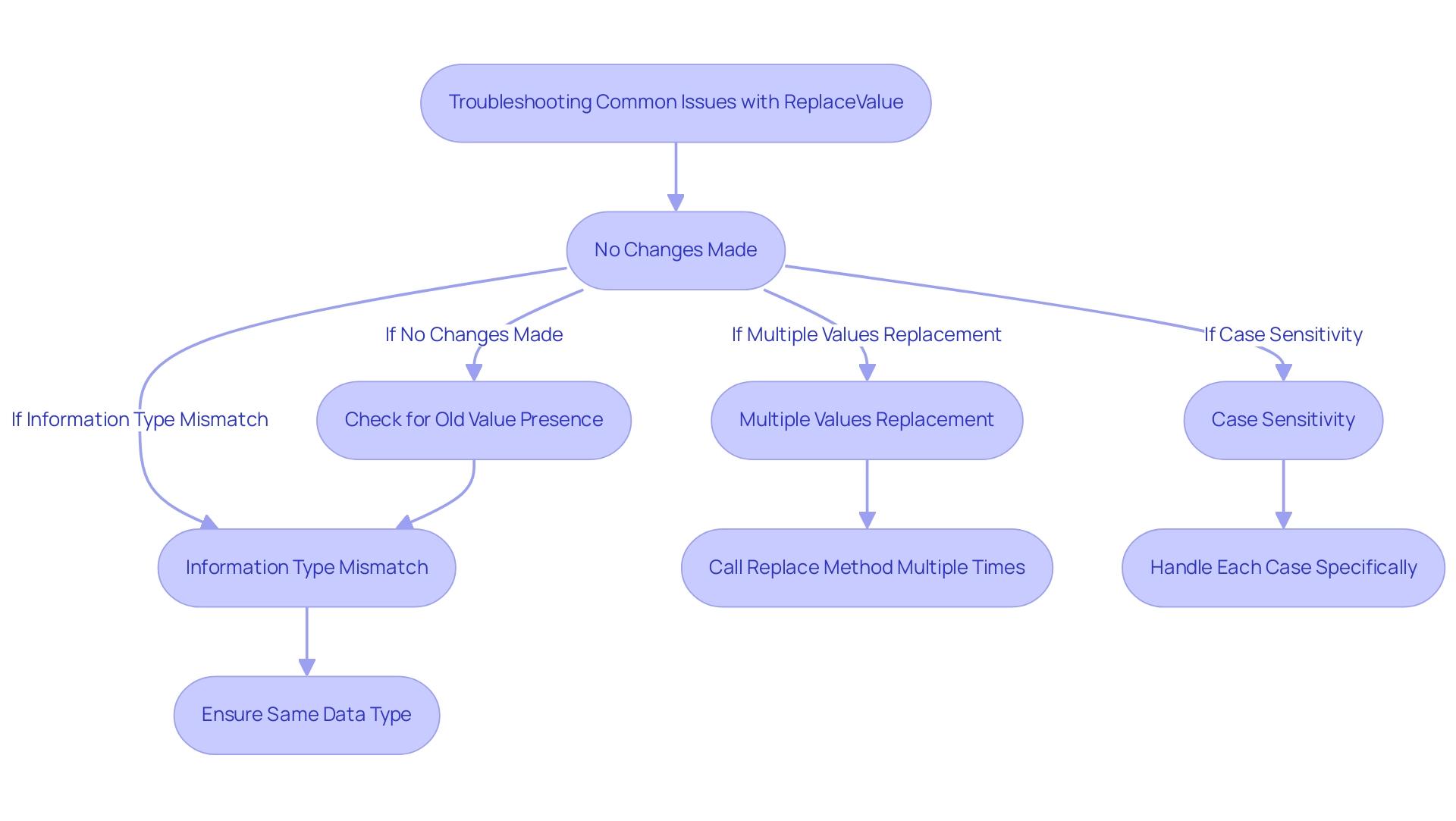
Advanced Techniques: Conditional and Bulk Replacements
To effectively execute conditional replacements with the power query replacevalue method, utilize the if... then statement within a custom column. For instance:
= if [Status] = 'Pending' then 'In Progress' else [Status]
This simple yet powerful technique allows you to customize value replacements based on specific conditions, enhancing the accuracy of your information, reducing errors, and supporting your operational goals in a rapidly evolving AI landscape.
In transformation processes, it is essential to ensure that the independent variables do not correlate highly with each other. Jeff Sauro emphasizes: ‘You also don’t want the independent variables to correlate highly with each other (usually r > .8)—a condition called multicollinearity, which renders the regression equation unreliable.’ This principle emphasizes the importance of effective information processing techniques in fostering insight-driven understanding and operational efficiency for business growth.
For more extensive changes, utilizing the List.Accumulate method can simplify the process of executing multiple replacements at once, a practice aligned with the efficiency objectives of RPA. Here’s how it works:
let
replacements = { { 'Y', 'Yes' }, { 'N', 'No' } },
result = List.Accumulate(replacements, yourTable, (state, current) => Table.ReplaceValue(state, current{0}, current{1}, Replacer.ReplaceValue, {'Response'}))
in
result
This approach not only simplifies bulk replacements but also optimizes your workflow, enabling you to transform data more efficiently, ultimately reducing errors and freeing up your team for more strategic, value-adding work.
By enhancing your data transformation capabilities in Power Query, you will ultimately lead to more insightful and actionable results, aligning your operations with the principles of RPA and business intelligence.
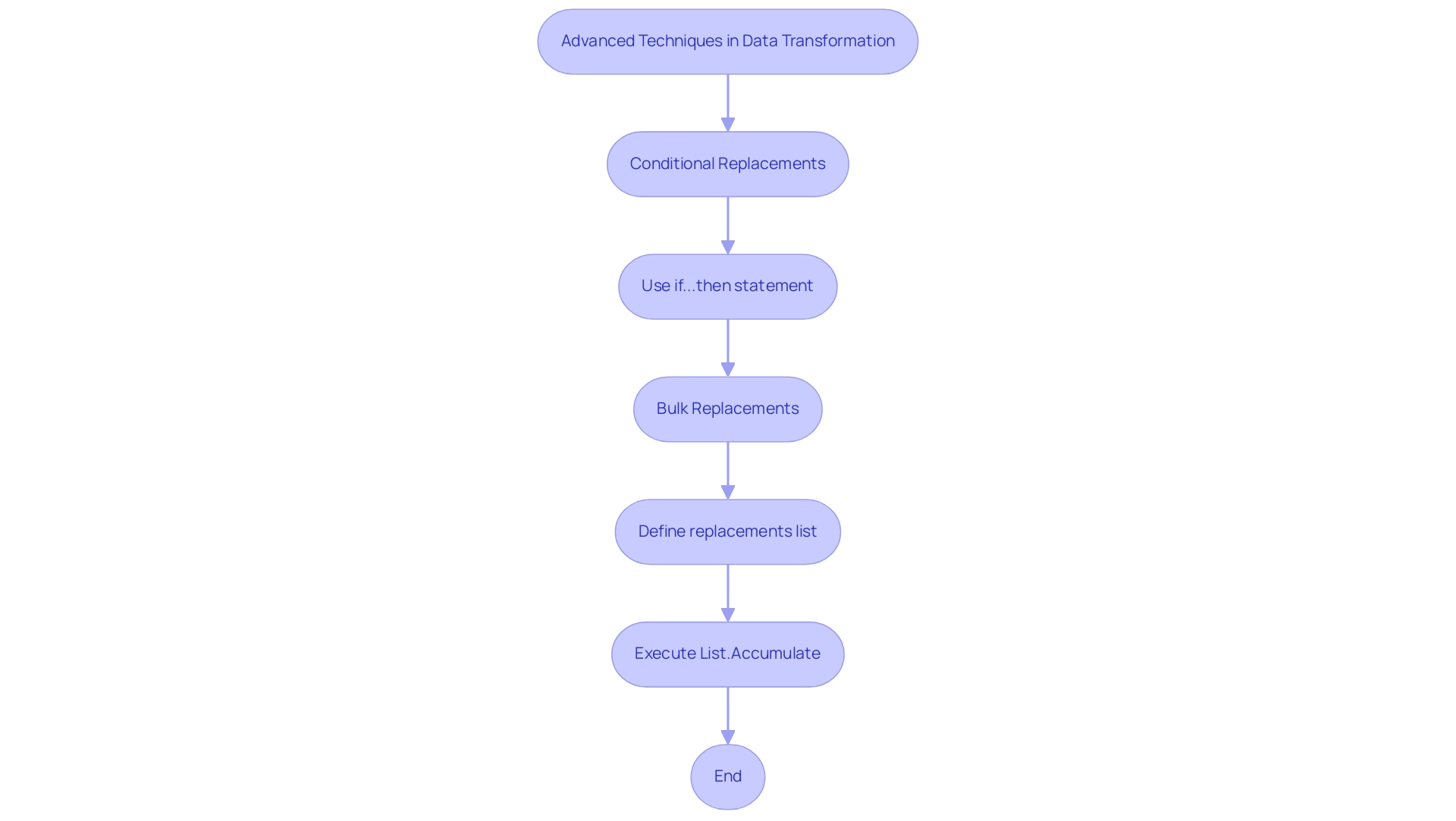
Best Practices for Effective Use of ReplaceValue in Power Query
To effectively utilize the substitution feature in Power Query while tackling common challenges in Power BI, such as time-consuming report generation and inconsistencies, it’s essential to adopt several best practices that enhance both safety and efficiency:
-
Always Backup Data: Before executing any replacements, ensure you create a backup of your original dataset. This precaution safeguards against accidental information loss and permits recovery if necessary, particularly significant when encountering the pressures of tight reporting timelines.
-
Test Replacements: Begin with a smaller dataset to test your substitution function. This approach helps you identify potential issues early, preventing complications when you scale up to larger datasets. For instance, one task involved replacing hundreds of incorrect URLs across 63 blog posts—testing on a smaller scale could have streamlined this process and reduced the overall reporting time.
-
Use Descriptive Names: When crafting custom columns or transformations, opt for descriptive names. This practice clarifies the purpose of each step, making future reference easier and aiding collaboration within your team. Clear naming conventions can also help reduce confusion that arises from inconsistencies.
-
Document Changes: Maintaining a record of modifications made using ReplaceValue is crucial. Documenting original and new values ensures traceability and transparency in your information processes. The case study titled ‘Documenting Cleaning Steps’ illustrates this well; by creating a documentation sheet that describes each step, specifies sources, details transformations, and records filters, teams can track and replicate processes, ensuring integrity and providing actionable guidance for stakeholders. As Neeraj Sharma aptly states,
Remember to regularly update and review the documentation for accuracy and relevance.
This practice is essential for preserving information integrity and trust in your reports. -
Review Value Types: Always verify that the types of the values you are replacing correspond accurately. Mismatched value types can result in errors, complicating your management efforts and the clarity of insights derived from your reports.
By adhering to these best practices, users can harness the full potential of the ReplaceValue function while safeguarding their information and enhancing their overall management strategy in Query. This approach not only prepares and manages information effectively for Power BI reports but also ensures that the insights derived are clear and actionable for stakeholders. Additionally, implementing governance strategies, such as regular audits of data processes and establishing clear guidelines for data usage, can help maintain consistency and trust in the data presented.
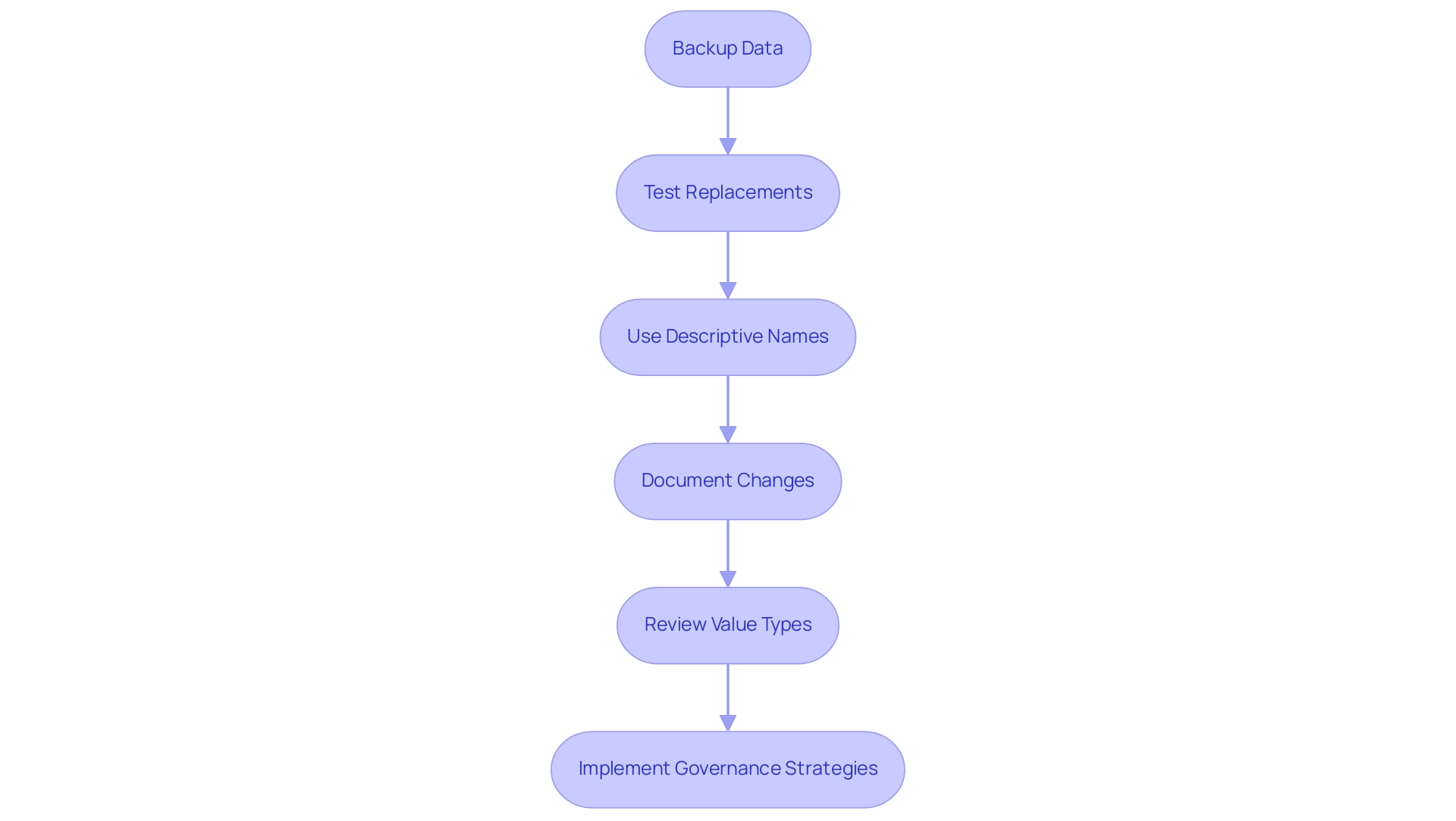
Conclusion
Mastering the ReplaceValue function in Power Query is an essential step towards achieving efficient and accurate data management. By understanding its practical applications, users can easily correct errors, standardize values, and enhance the overall quality of their datasets. The function not only simplifies the data cleaning process but also integrates seamlessly with Robotic Process Automation tools, paving the way for streamlined workflows and reduced manual effort.
Addressing common troubleshooting issues ensures that users can effectively utilize the ReplaceValue function without unnecessary complications. By implementing best practices such as:
– Backing up data
– Testing replacements
– Documenting changes
organizations can safeguard their data integrity while fostering a culture of transparency and collaboration.
Ultimately, the ability to transform data accurately and efficiently is crucial in today’s data-driven landscape. By leveraging the capabilities of Power Query and the ReplaceValue function, businesses can unlock valuable insights that drive informed decision-making and support strategic growth. Embracing these tools and techniques not only enhances operational efficiency but also positions organizations to thrive in an increasingly competitive environment. Now is the time to harness the power of effective data management to propel your organization forward.

